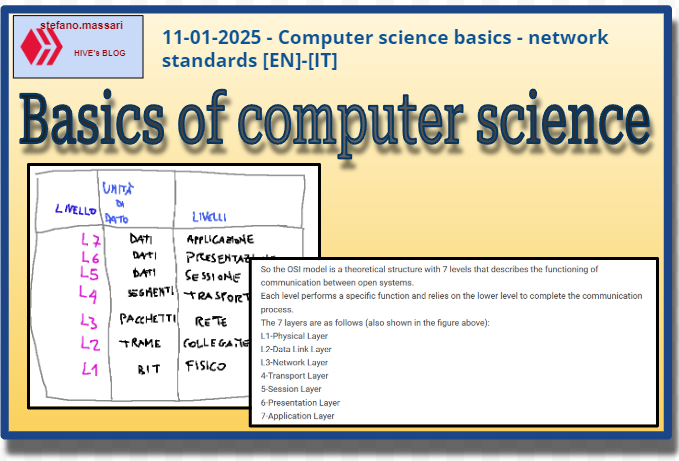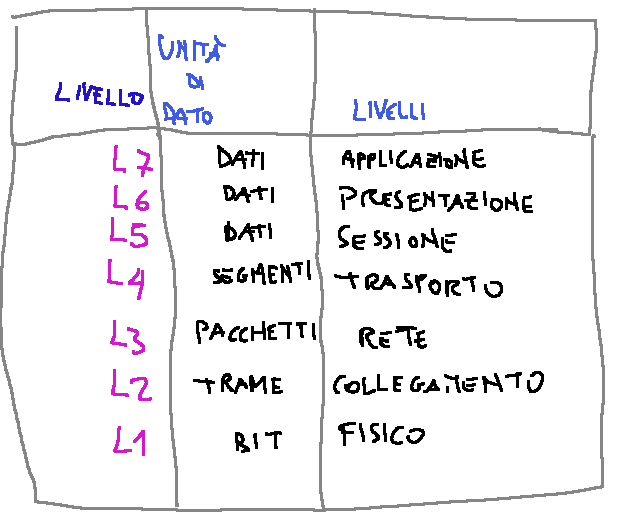
~~~ La versione in italiano inizia subito dopo la versione in inglese ~~~
ENGLISH
11-01-2025 - Computer science basics - network standards [EN]-[IT]
With this post I would like to give a brief instruction on the topic mentioned in the subject
(code notes: X_70)
network standards
Let's start from the main concept that communication networks allow the exchange of information between devices. This exchange of information occurs through infrastructures that use standardized protocols. Among the main conceptual references for understanding and designing communication networks we find the ISO/OSI (Open Systems Interconnection) model.
The Open System Interconnection (known as OSI) is a standard for networks promoted by the International Standard Organization (ISO) in 1980. The ISO/OSI model defines the architecture of open systems that exchange information on a heterogeneous communication network.
The ISO/OSI model is structured in 7 levels organized in a hierarchical way (protocol stack): the lowest level (Level 1) interfaces with the physical transmission medium, while the highest level (Level 7) interfaces directly with the user.
Below is a diagram of the OSI model

So the OSI model is a theoretical structure with 7 levels that describes the functioning of communication between open systems.
Each level performs a specific function and relies on the lower level to complete the communication process.
The 7 layers are as follows (also shown in the figure above):
L1-Physical Layer
L2-Data Link Layer
L3-Network Layer
4-Transport Layer
5-Session Layer
6-Presentation Layer
7-Application Layer
The advantages of this communication model are: standardization, interoperability, modularity and ease of diagnosis.
Here are some information pills regarding the subject in question.
1-The ISO/OSI model
The ISO/OSI model defines the architecture of open systems that exchange information on a heterogeneous communication network
2-The network-oriented layers
The network-oriented layers are the following:
Physical Layer
Link Layer
Network Layer
3-Interface with the user
The layer that interfaces directly with the user is the application layer, i.e. layer 7.
**4-Encapsulation **
Encapsulation is the process of enveloping
5-Fragmentation
During the fragmentation process, the data is broken down into small units called packets
6-Functions of the physical layer
The physical layer has the function of defining the characteristics of the transmission devices, establishing the direction of transmission and establishing the type of signals transmitted
7-The transport layer
The level transport is concerned with providing a secure channel for the transparent and reliable transfer of data
8-The presentation layer
The presentation layer is concerned with managing the syntax of the information to be transferred along the entire path
9-The decapsulation process
During the decapsulation process, the packet is stripped of additional information for each layer it passes through
**10-Interface with the physical medium **
the level that interfaces with the physical transmission medium is simply level 1, i.e. the physical level.
Conclusions
The ISO/OSI model represents a pillar for understanding communication networks. To date, it is not implemented in modern networks but it is essential for understanding the operating principles of protocols and network infrastructures.
Question
In the 80s, it was already widely understood that a communication standard for networks was needed, even though some companies still did not have computer networks. The OSI model describes how communication between open systems works. Did you know that it was developed by the International Organization for Standardization back in 1980?

[ITALIAN]
11-01-2025 - Basi di informatica - standard per reti [EN]-[IT]
Con questo post vorrei dare una breve istruzione a riguardo dell’argomento citato in oggetto
(code notes: X_70)
standard per reti
Partiamo dal concetto principale che le reti di comunicazione permettono lo scambio di informazioni tra dispositivi. Questo scambio di informazioni avviene attraverso infrastrutture che utilizzano protocolli standardizzati. Tra i principali riferimenti concettuali per la comprensione e progettazione di reti di comunicazione troviamo il modello ISO/OSI (Open Systems Interconnection).
L’Open System Interconnection (conosciuto come OSI) è uno standard per reti promosso dall’International Standard Organization (ISO) nel 1980. Il modello ISO/OSI definisce l’architettura di sistemi aperti che si scambiano informazioni su una rete di comunicazione eterogena.
Il modello ISO/OSI è strutturato in 7 livelli organizzati in modo gerarchico (pila protocollare): il livello più basso (Livello 1) si interfaccia con il mezzo fisico di trasmissione, mentre li livello più alto (Livello 7) si interfaccia direttamente con l’utente.
Qui di seguito uno schema del modello OSI

Quindi il modello OSI Il è una struttura teorica a 7 livelli che descrive il funzionamento della comunicazione tra sistemi aperti.
Ogni livello svolge una funzione specifica e si appoggia sul livello inferiore per completare il processo di comunicazione.
I 7 livelli sono i seguenti (sono riportati anche nella figura sopra):
L1-Livello Fisico
L2-Livello di Collegamento Dati
L3-Livello di Rete
4-Livello di Trasporto
5-Livello di Sessione
6-Livello di Presentazione
7-Livello Applicazione
I vantaggi di questo modello di comunicazione sono: la standardizzazione, l'interoperabilità, la modularità e la facilità di diagnosi.
Qui di seguito alcune pillole di informazioni a riguardo dell’argomento in oggetto.
1-Il modello ISO/OSI
Il modello ISO/OSI definisce l’architettura di sistemi aperti che si scambiano informazioni su una rete di comunicazione eterogena
2-I livelli orientati alla rete
I livelli orientati alla rete sono i seguenti:
Livello Fisico
Livello Collegamento
Livello Rete
3-Interfaccia con l'utente
Il livello che si interfaccia direttamente con l'utente è il livello applicazione, cioè il livello 7.
**4-L'incapsulamento **
L'incapsulamento è il processo di imbustamento
5-Frammentazione
Durante il processo di frammentazione, i dati sono scomposti in piccole unità dette pacchetti
6-Funzioni del livello fisico
Il livello fisico ha la funzione di definire le caratteristiche degli apparati trasmissivi, stabilire il verso della trasmissione è stabilire la tipologia di segnali trasmessi
7-Il livello trasporto
Il livello trasporto si occupa di fornire un canale sicuro per il trasferimento trasparente e affidabile dei dati
8-Il livello presentazione
Il livello presentazione si occupa di gestire la sintassi dell’informazione da trasferire lungo l’intero percorso
9-Il processo di decapsulamento
Durante il processo di decapsulamento al pacchetto viene tolta l’informazione aggiuntiva per ogni livello che attraversa
**10-Interfaccia con il mezzo fisico **
il livello che si interfaccia con il mezzo fisico di trasmissione è semplicemente il livello 1, cioè il livello fisico.
Conclusioni
Il modello ISO/OSI rappresenta un pilastro per la comprensione delle reti di comunicazione. Ad oggi non è implementato nelle reti moderne ma è fondamentale per comprendere i principi di funzionamento dei protocolli e delle infrastrutture di rete.
Domanda
Negli anni 80 si era già ampiamente compreso che ci voleva una standard di comunicazione per le reti, nonostante alcune aziende ancora non possedevano reti informatiche. Il modello OSI descrive il funzionamento della comunicazione tra sistemi aperti, sapevate che era stato sviluppato dall'International Organization for Standardization già nel 1980?
THE END
Your class is always well explained
Thank you
Good lecture. I don't have the basics about computer science
Good lecture. I don't have the basics about computer science
😎👍🏾 @tipu curate
Upvoted 👌 (Mana: 0/51) Liquid rewards.
Thanks for support and drop TIPU
#hive #posh